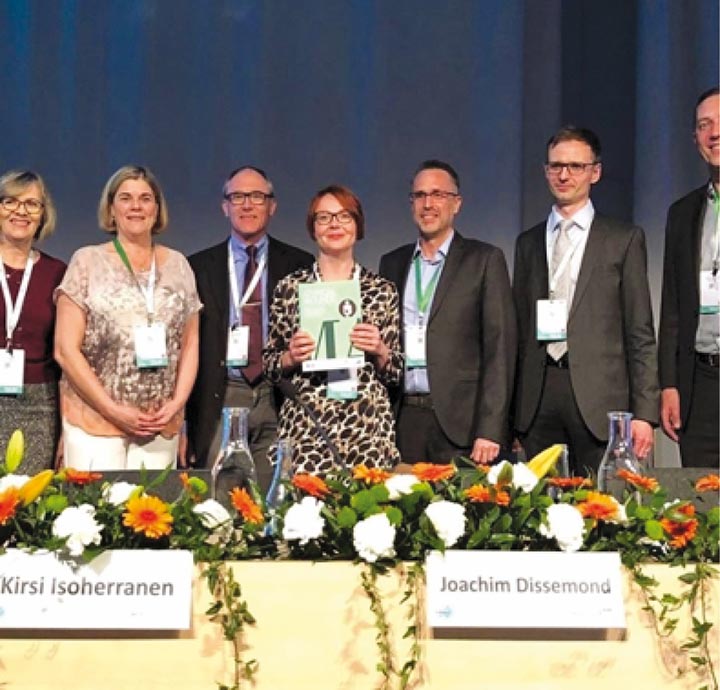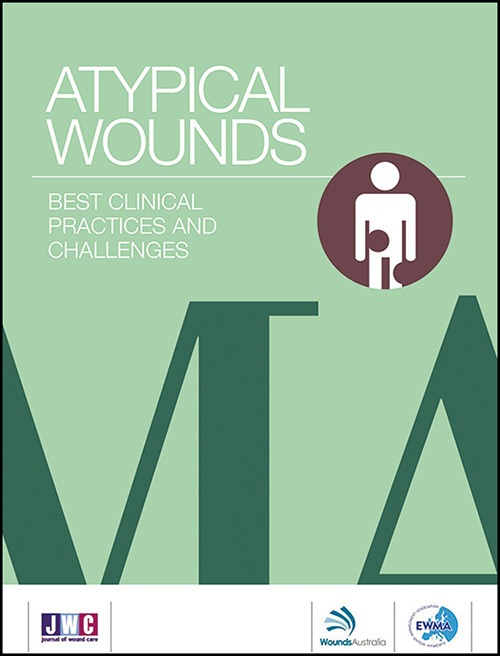Volume 28 Number 3
Atypical Wounds - Best Clinical Practices and Challenges
Judith Barker
For referencing Barker J. Book review – Atypical Wounds - Best Clinical Practices and Challenges. Wound Practice and Research 2020; 28(3):143-144.
DOI https://doi.org/10.33235/wpr.28.3.143-144
Reviewer
Judith Barker, Nurse Practitioner – Wound Management, Rehabilitation, Aged and Community Care., Adjunct Associate Professor, University of Canberra, Canberra, Australia
Title
Atypical Wounds - Best Clinical Practices and Challenges
The development of this document is a collaborative project between the European Wound Management Association (EWMA) and Wounds Australia.
Launched - EWMA Conference 2019 Gothenburg, Sweden
Author Group
Kirsi Isoherranen (Editor), MD, PhD, Helsinki University Central Hospital and Helsinki University, Wound Healing Centre and Dermatology Clinic, Helsinki, Finland
Julie Jordan O’Brien (Co-editor), RNP, MSc Nursing, Advanced Nurse Practitioner Plastic Surgery, Beaumont Hospital, Dublin, Ireland
Judith Barker, Nurse Practitioner – Wound Management, Rehabilitation, Aged and Community Care., Adjunct Associate Professor, University of Canberra, Canberra, Australia
Joachim Dissemond (JD), Professor, MD, University Hospital of Essen, Department of Dermatology, Venerology and Allergology, Hufelandstraße 55, Essen, Germany
Jürg Hafner, Professor, MD, Department of Dermatology, University Hospital of Zurich, Gloriastrasse 31, Zurich, Switzerland
Gregor B. E. Jemec (GJ), Professor, MD, Department of Dermatology, Zealand University Hospital, Roskilde, Denmark
Jivko Kamarachev (JK), MD, PHD, Department of Dermatology, University Hospital of Zurich, Gloriastrasse 31, Zurich, Switzerland
Severin Läuchli, MD, PHD, Department of Dermatology, University Hospital of Zurich, Gloriastrasse 31, Zurich, Switzerland
Elena Conde Montero, MD, PHD, Hospital Universitario Infanta Leonor, Dept. of Dermatology, Madrid, Spain
Stephan Nobbe (SN), MD, Department of Dermatology, University Hospital of Zurich, Gloriastrasse 31, Zurich, Switzerland Department of Dermatology, Cantonal Hospital of Frauenfeld, Switzerland
Cord Sunderkötter (CS), Professor, MD and Chair, Department of Dermatology and Venerology, University and University Hospital of Halle, Ernst-Grube-Strasse 40, Halle, Germany
Mar Llamas Velasco, MD, PhD, Department of Dermatology, Hospital Universitario De La Princesa, Madrid, Spain.
Publisher
European Wound Management Association
Published on behalf of EWMA by MA Healthcare Ltd.
Editor
Rachel Webb
Year published
2019
Background
Timely diagnosis of atypical wounds is very challenging for clinicians and patients from a prevention, treatment and organisational perspective. Atypical wounds are generally understood as wounds that cannot be defined under one of the primary non healing wound categories, such as venous, arterial, mixed or diabetic foot ulcers. They present a broad spectrum of conditions or diseases caused by inflammation, infection, malignancy, chronic illnesses or genetic disorders.
An atypical wound can be suspected if the wound has an abnormal presentation or location, pain out of proportion of the size of the wound and does not heal within four to 12 weeks with a good treatment plan.
The prevalence of atypical wounds can be as high as 20% of all chronic wounds and many of these wounds are underdiagnosed. Challenges include considerable diagnostic delay and pro-longed healing times which have an enormous impact on the quality of life for the affected individuals. It is therefore important that every health professional treating these wounds is familiar with this entity or at least has the knowledge to suspect an atypical wound and when to refer the patient to an expert.
The European Wound Management Association established a working group of experts to gather the best available knowledge on atypical wounds and conduct a literature review on available evidence. This document is targeted at increasing awareness of the clinical picture, diagnosis and treatment of these wounds among health professionals and to provide practical advice on some of the challenges that typically arise.
Chapter structure
Atypical Wounds - Best Clinical Practices and Challenges - This document aims to increase awareness of atypical wounds and focus on wounds caused by inflammation, malignancy and chronic illnesses.
Each chapter discusses an atypical wound and includes the incidence, aetiology, pathophysiology, clinical presentation, diagnostics, differential diagnosis, treatment/therapy and prognosis. The histopathology is covered in detail, with biopsy techniques to assist the clinician in the correct procedure to determine a diagnosis.
There are 18 chapters
- Introduction
- Pyoderma gangrenosum
- Vasculitides as causes of wounds
- Occlusive vasculopathy
- Martorell HYTILU and calciphylaxis: skin infarction and acral gangrene from ischaemic arteriolosclerosis
- Hidradenitis suppurativa
- Malignant wounds
- Artefactal ulcers
- Ecthyma and ecthyma gangrenosum
- Other types of atypical wounds
- Histology of atypical wounds
- Practical aspects of diagnosing and treating atypical wounds
- Topical treatment for atypical wounds
- The patient perspective
- Health economy and organisation
- Conclusion and future perspectives
- References
- Glossary
Graphics
- 11 tables of clear comprehensive and practical guidance for the clinician
- 46 figures – atypical wound appearance and histopathology images
Chapter Content
- The document presents the diagnostic criteria, comorbidities and diagnostic tools for wounds defined as atypical, including practical hints for health professionals
- The best available current treatment options and some newer treatment options are included
- Provides guidance to reduce the diagnostic delay by including up to date evidence-based literature on atypical wounds
- The topic of atypical wounds is very well covered and comprehensive. It has a very helpful algorithm in Chapter 12 on the practical aspects of diagnosing and treating atypical wounds to assist the clinician in early diagnosis and treatment in a systematic way
- The document is well referenced with 355 articles. The levels of evidence are not included, but the working party reviewed the literature from a global perspective
Future research
- The final chapter highlights future perspectives and more research is required on atypical wounds to support clinicians, patients, organisations and the health economy
- A challenge for the management of atypical wounds is the lack of consensus and guidelines for the standardisation of treatment and the lack of economic studies. Moreover, most research in the area of atypical wound management is currently focused on wound outcomes during the wound-healing phase without taking into consideration the high rate of recurrences.
The target audience
A multidisciplinary team of professionals, consisting of a dermatologist, vascular and plastic surgeon, rheumatologist, diabetologist, nephrologist, infectious disease specialist, psychiatrist, wound nurses, podiatrist, nephrologist, psychologist, nutritionist, physiotherapist, podiatrist and a social care worker, is needed to manage this group of patients. However, it is mainly community health professionals who manages these patients on a day-to-day basis. This document targets all health professionals.
Recommendations
Highly recommended – this is an excellent resource for all clinicians. The beginning to the advanced clinician will find this resource invaluable.
Summary
The take home message from the working party – “To emphasise the importance of early suspicion and diagnosis and expert consultation with these wounds. The ‘wait and see’– attitude can lead to devastating outcomes. We hope the algorithm helps in daily practice in the systematic assessment of these wounds and that the document will be disseminated and used among all health professionals treating chronic wounds”.

Members of the Working Group at the launch in Gothenburg, Sweden.
Author(s)
Judith Barker
Nurse Practitioner – Wound Management, Rehabilitation, Aged and Community Care.,
Adjunct Associate Professor, University of Canberra, Canberra, Australia
References
Isoherranen K, Jordan O’Brien J, Barker J et al. EWMA document; Atypical wounds. Best clinical practices and challenges




